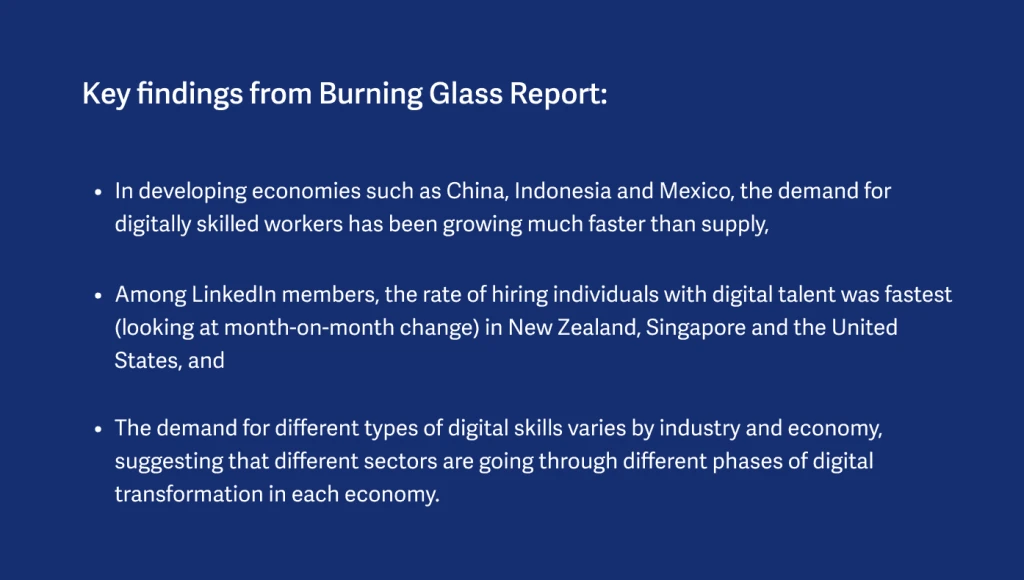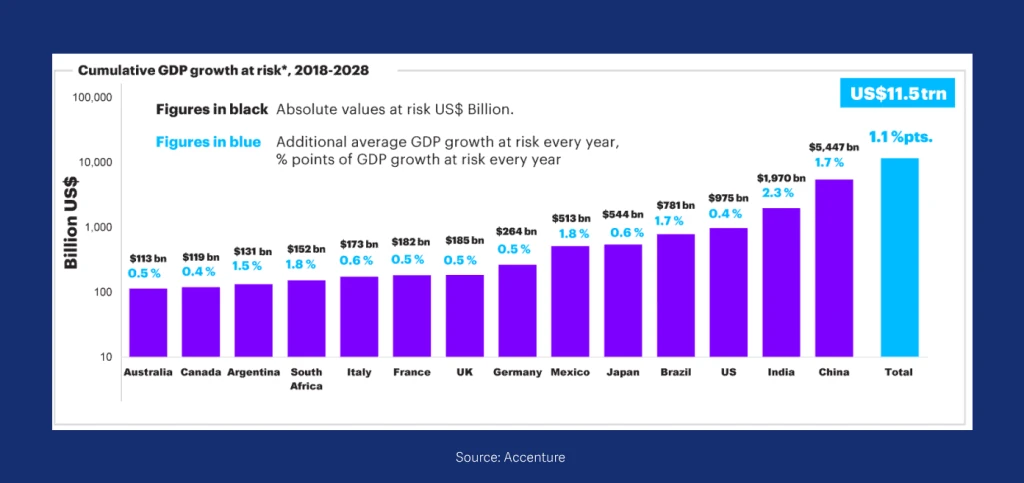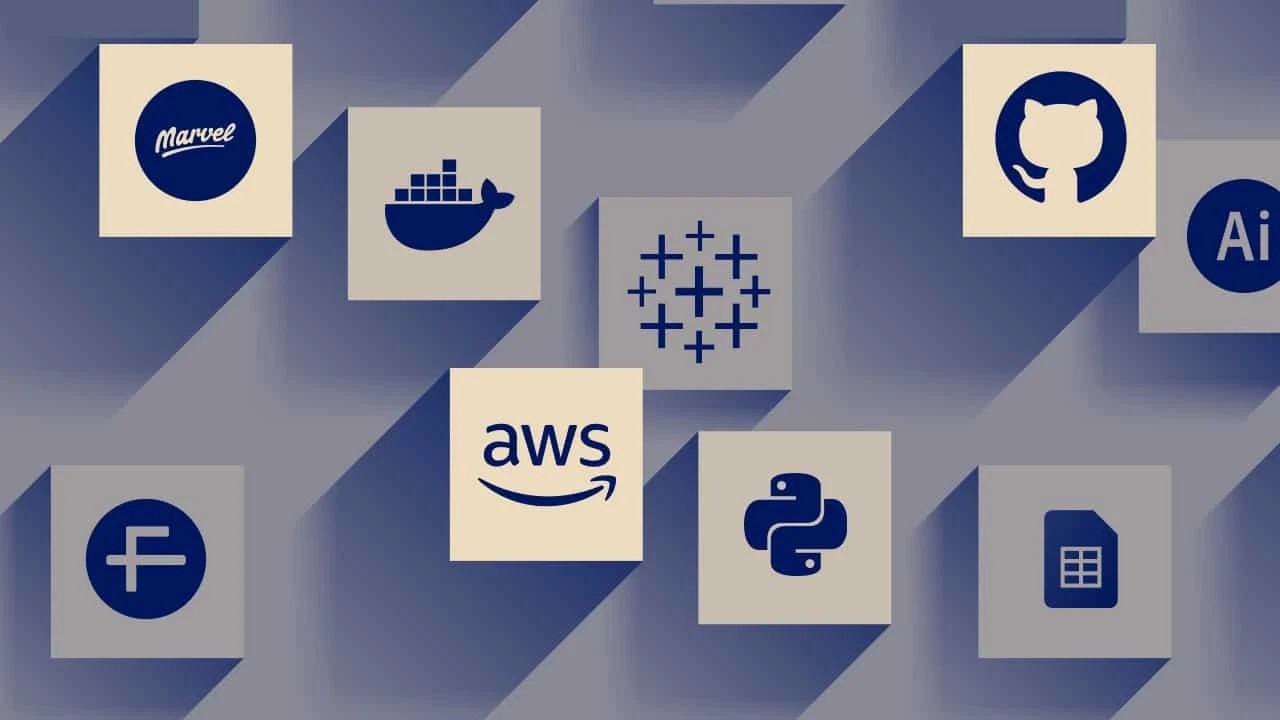With the economies becoming more data-centric – the demand for digital skills has been on a steep rise, further dramatized by the pandemic – leading to a huge skills gap across industries.
Increase need for digital skills and emerging gap
Organizations across industries are looking at building and leveraging digital skills, led by industry 4.0, and economies becoming more digital and data-driven. The digital disruption is further accelerated by the pandemic, which has made it evident that the future of businesses will be hyper digital and largely contactless. Technology service providers across both developed and developing economies are witnessing significant growth in digital deals, cloud spending and increasing spend in customer experience since the coronavirus outbreak.
While the demand is high, and set to continue to increase in future, organizations are already struggling to bridge this talent gap.
An estimated one million tech jobs went unfulfilled in 2020, signaling a huge technology talent deficit in the U.S.
Further Digital and technology skills are not just limited to tech workers or certain management cadres, but are required across the levels in the workforce, spanning various industries.

If G20 countries are unable to adapt the supply of skills to meet the needs of the new technological era, they risk forgoing up to US$11.5 trillion in GDP growth over the next 10 years.

A look at the top 10 emerging digital skills and in-demand roles
1. Artificial Intelligence and Machine Learning
Artificial Intelligence (A.I.) is a simplified problem-solving process for humans, enabling software to perform tasks without being explicitly programmed.
Key AI skills include natural language processing (NLP), automated speech recognition (ASR) and automation, and AIOps (artificial intelligence operations).
Machine Learning is an application of Artificial Intelligence (AI) that enables machines to access data and let them learn to perform these tasks. From Siri and Alexa to chatbots to predictive analysis to self-driving cars, there are a ton of uses for this futuristic tech.
Key ML roles include data scientist, machine learning engineer, business intelligence developer, robotic scientist, designer in human-centric machine learning, and software engineer.
2. Data Science and analytics
Two consistently in-demand tech jobs within Big Data include data science and data analytics. Data analysis is the more entry-level skill, whereas data science gets more advanced, but the careers are still cousins. Data visualization is another critical skill commonly used by both data scientists and data analysts, but can also be helpful in digital marketing roles.
Relevant skills include data visualizations via Google Sheets, Tableau, Highcharts, Carto, Leaflet, GitHub, Python, etc.
3. Network and Information Security (Cybersecurity)
For any company that collects customer information or deals with sensitive data of their own, keeping networks secure is paramount. The number of data breaches has increased steadily over the past. Further emergence of work from home has enhanced the need for network and data security. Led by increasing demand, the talent gap in cybersecurity is expected to reach 3.5 million unfilled jobs by 2022 – tripling from 2017.
Relevant skills include application and network security, forensics, incident response, security architecture, threat intelligence, etc.
4. Cloud Computing/AWS
Cloud computing jobs are on the rise because more and more companies are switching from the classical server infrastructure to cloud solutions. According to Forrester Research, the market for global public cloud services will grow 35% to $120 billion in 2021.
The most in-demand cloud computing skills include Amazon Web Services (AWS), Java, Linux, software development, DevOps, Docker, and Infrastructure as a Service (IaaS).
5. UI/UX Design
While they’re in the same family, UI and UX are different. UI (user interface) specialists design interfaces for websites and apps to be visually appealing, flow well, and be easy for users to navigate. UX (user experience) specialists do a lot of research and testing to consider every element of how the user will interact with the company and website, coordinating with developers and UI designers. UX design is one of the top five in-demand hard skills according to LinkedIn. Demand for UX/UI skills is mostly in mobile platforms, but demand for innovative design in VR, AR, AI, and wearables is also growing.
UX and UI designers require both core skills like strategy, scope, structure, skeleton, and surface and knowledge of specific tools like Marvel, Adobe Illustrator, Zeplin, Flinto, etc.
6. Product Management
COVID-19 has accelerated digital adoption by major firms by as much as 5 years, which means demand for product managers is likely to increase. Glassdoor lists it as the #4 best job in America for 2020.
Product management is an increasingly hybrid role requiring skills across business, customer, and data understanding and technical deployment.
7. Salesforce/CRMs
Demand for Salesforce developers has been seeing an increased demand during the pandemic. “It’s not a coincidence that more organizations are looking to optimize and automate their business flows, especially during the COVID-crisis, and Salesforce is known for being the best solution for doing so.”, says Dmitriy Ogol via Salesforce Ben. Salesforce developer is #10 on Indeed’s best jobs of 2019. International Data Corporation research showed that Salesforce would help create 3.3 million new jobs by 2022.
8. Digital Marketing
Marketing itself has been revolutionized by technology, offering new channels such as social media, affiliate marketing (another top LinkedIn skill), and digital content. Further, the use of analytic tools for data collection, performance measurement, and decision-making is another emerging digital skill for traditional marketers. Emerging roles include social media manager, affiliate marketing manager, etc.
Another one strictly related to digital marketing is content creation which is now heavily dependent on AI tools. Along with that, there are also useful AI Detector tools to make sure that your content looks human-like to your audience.
9. Low-Code Platforms and Programming
On Glassdoor’s list of top jobs for 2020, careers requiring coding skills are well-represented. Front-end engineering is their #1 best job, Java developer is #2, software engineer is #7, etc. Full-stack engineering has seen 35% hiring growth every year since 2015. In addition to traditional software development, emerging trend is towards the use of low-code platforms. Low-code involves “coding” using a drag-and-drop interface, pre-built templates, and other visual elements that take much less time than traditional coding. Further related skills gaining traction is mobile expertise and app development.
10. Other advanced emerging tech roles
Blockchain: Between 2017-18, demand for blockchain engineers increased by 400%. Tech giants like Facebook, Amazon, IBM and Microsoft are working on blockchain. Originally devised for the digital currency Bitcoin, blockchain is now finding other potential uses for the technology, such as peer-to-peer payments, crowdfunding, file storage, identity management, digital voting, etc.
Virtual reality and augmented reality (Extended Reality, XR) Marketing, advertising, health care, and manufacturing are some industries that have already begun adopting XR technology. According to Hired’s 2019 State of Software Engineers report, demand for AR and VR engineers surged by an incredible 1,400%.
**Internet of Things (IoT)**is poised to be the next tech jobs boom, with an estimate of more than 75 billion IoT devices to be connected to the web by 2025 and various companies shaping their IoT strategies. This has led to increasing demand for IoT roles like senior solutions architects, IoT cloud systems engineers, big data engineers, etc. Further IoT requires expertise in hybrid skills acrosshardware, networking, design and development, security, data analytics, and artificial intelligence, which has further added to the emerging talent gap.
Bridging the digital skills gaps
Addressing the digital skills gap is now recognized globally as an important driver of increased business competitiveness, employee performance and satisfaction, and customer experience (Capgemini, LinkedIn). Various campaigns, projects, and initiatives are already underway across private and public sectors to close the gap, and their number is increasing.
Businesses have an important role to play in providing digital opportunities:
-
Promoting tech careers as a platform for fair progression, meaningful, lifelong learning and enjoyment.
-
Executing far-reaching programs that smash institutional barriers such as poor access to skilling and racial and gender inequality.
-
Resetting recruitment to focus less on traditional education and more on skills, opening up digital roles to a wider, more diverse talent pool and delivering a more positive socio-economic impact.
-
Creating non-traditional pathways into the tech industry.
Now more than ever, businesses must work closely with governments and community stakeholders to ensure that training scales up to match digital demand and accelerate recovery and growth.

What the organizations can do
The shortage of people with digital skills is leading to a war for talent among companies, which, in turn, is leading them to pay higher salaries and offer multiple hikes in a year as a retention strategy. Organizations across industries are on a hiring spree either to fulfill current demands or to make investments for future growth.
IT companies are reviewing compensations and providing multiple increments within the year to retain talent.
Other than retention focus, organizations need to actively invest in assessing and building the digital talent in parallel to bridge this skill gap.
1. Identify skill gaps and skill adjacencies
HR leaders need to work with their CEO, CFO and CIO to rethink skills needs as business models change rapidly. HR leaders can help their organizations address digital skills gaps is by assessing their current workforce and identifying employees with skills adjacent to the ones needed. Mapping skills adjacencies can help identify the shortest pathways between the skills employees already have and the skills the organization needs.
2. Reskilling and upskilling employee program
Further employers need to start prioritizing reskilling and upskilling programs to bridge the digital talent gaps. According to a report by Randstad RiseSmart, all surveyed employers and professionals agreed that upskilling and reskilling add value to an organization. Of those that offered skilling, nearly all employers (98%) said employees either fully or partially used the skills they learned to benefit the business, and 94% of employees said they either fully or partially put their new or refreshed skills to use in a meaningful way.
3. Hire-Train-Deploy Model
To address the demand-supply gap, companies can also adopt a hire-train-deploy (HTD) model wherein employees, especially freshers, are trained by specialist staffing firms on the exact skill requirements before deploying them with the clients. Technology staffing firm TeamLease Digital said it has partnered with multiple customers on skills such as SAP Hana, CyberArk, Informatica and Oracle to train both freshers and experienced people before deploying them in projects.
Companies which are doing it right
Companies like GE have founded training initiatives that integrate continuous learning into their corporate culture. Trailhead, Salesforce’s free online learning platform, is also a game-changing model that helps people with little technical knowledge skill up for roles in the Salesforce ecosystem, from anywhere and at their own pace. Salesforce’s Trailblazer Community allows members to share knowledge and provide mutual support for navigating the educational process. Startups like Coursera and the Khan Academy have demonstrated the promise of an immersive and modern online learning experience without the traditional burden of cost.
“Ultimately, all companies need to see themselves as education companies.”
Democratizing education is key to closing the digital skills gap and ensuring the fruits of technological innovation are distributed equitably. The mission for these companies is no longer just to produce products and services, but also to integrate educational experiences into the context of work.
The Takeaway
As the workforce gets digitized so does the HR function. By leveraging the upcoming technology themselves and gaining a clear understanding of their organization’s digital transformation needs, HR will be in a better position to attract and retain a talent group that matches the balance of skills required.
